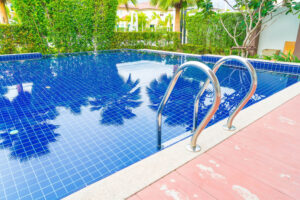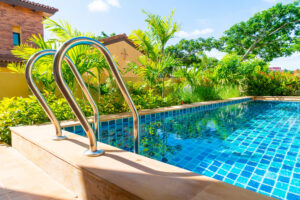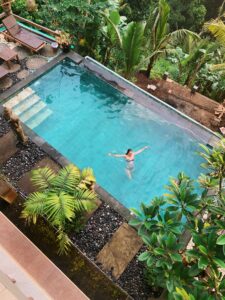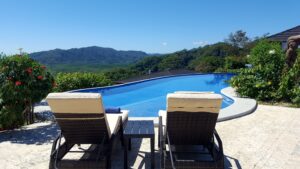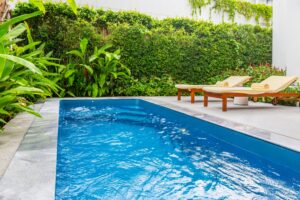Looking for the perfect plunge pool depth for your home? You’re not alone. Many homeowners struggle with this decision of how deep should a plunge pool be.
Most plunge pools range in depth from 4 to 8 feet, with the average being between 4 and 6 feet deep. This depth range provides enough water for relaxation and cooling off while remaining safe and practical for most users. If you plan to use your plunge pool for swimming laps, we recommend a minimum depth of 4.5 feet to allow proper swimming strokes.
Your ideal plunge pool depth ultimately depends on your specific needs and space constraints. Smaller yards might work better with shallower pools around 4 feet deep, while those wanting a more immersive experience might prefer depths closer to 6 feet.
We’ve created this guide to help you understand all the factors that should influence your decision. You’ll learn how deep a plunge pool should be to balance safety, comfort, and function through the following topics:
- What is the standard depth of a plunge pool?
- How to choose the ideal plunge pool depth for your home
- Custom vs Prefab: How depth varies by pool type
- Real-world examples: Plunge pool depth by use case
Let’s break down the key points you should consider when choosing the ideal plunge pool depth for your home.
What is the standard depth of a plunge pool?
Plunge pools typically have a specific depth range that balances safety, functionality, and comfort. The standard depth serves different purposes compared to traditional swimming pools and can significantly impact your overall experience.
Typical plunge pool depth range in feet and meters
Most plunge pools have a depth between 4 to 7 feet (1.2 to 2.1 meters). This range allows adults to stand comfortably while still providing enough depth for cooling off.
Shallower plunge pools, around 4 feet (1.2 meters), are ideal for lounging and casual use. They’re safer for families with children while still offering cooling benefits.
Deeper options, around 5.5 to 7 feet (1.7 to 2.1 meters), provide a more immersive experience. These depths allow for more therapeutic benefits and full-body submersion.
Some luxury plunge pools may reach depths of 8 feet (2.4 meters), but this is less common for residential installations.
How Plunge pools differ from regular pools in depth
Plunge pools are intentionally designed with different depth considerations than standard swimming pools. Traditional pools often have a sloped bottom that ranges from 3 to 9 feet deep.
Plunge pools maintain a consistent depth throughout, without the graduated shallow-to-deep design. This uniform depth maximizes the usable space in a smaller footprint.
The focused depth of plunge pools supports their primary functions: relaxation, cooling off, and hydrotherapy rather than swimming laps or diving. Their compact nature means every inch of depth is purposeful.
Regular pools require various depths for different activities, while plunge pools prioritize depth that allows for comfortable standing while still providing cooling immersion.
Depth vs Dimensions: What really matters for users
When planning a plunge pool, the relationship between depth and horizontal dimensions significantly impacts user experience. A well-proportioned plunge pool balances all measurements.
Important considerations:
- Deeper pools (6+ feet) work best with larger footprints (at least 8×12 feet)
- Shallower depths (4-5 feet) are more appropriate for smaller pools
- Your height matters—taller individuals may prefer deeper options
The rectangular shape maximizes usable space, with 8×16 feet being a popular dimension choice for residential properties. This shape works well with depths between 4-6 feet.
For therapeutic purposes, depth becomes more important than width or length. A depth that allows water to reach your shoulders when seated provides optimal relaxation benefits.
How to choose the ideal plunge pool depth for your home
Selecting the right depth for your plunge pool depends on several key factors that affect both functionality and safety. The perfect depth will vary based on who uses the pool, how you plan to use it, and important safety considerations.
Who will use the pool: Adults, kids, therapy?
User demographics significantly impact your ideal plunge pool depth. For adult-only households, depths between 4-5 feet work well for general relaxation. This depth allows full body submersion while standing.
For families with children, consider a variable depth design. A shallow end of 3-3.5 feet provides safe areas for kids while still allowing a deeper section of 4-5 feet for adults.
If you’re planning therapeutic use, deeper options around 5-6 feet may be better. This depth provides enough water resistance for aquatic therapy exercises and full-body immersion.
Senior users might benefit from a moderate 4-foot depth with built-in seating ledges or benches. This allows easy entry and exit while still providing adequate water coverage.
Cold plunge vs warm soak: How usage affects depth
Your intended use directly influences the optimal depth choice. For cold plunge therapy, depths of 4-5 feet are ideal. This allows full immersion while enabling you to move around to stimulate circulation.
Cold plunge pools typically benefit from being slightly deeper (4.5-5 feet) to ensure complete body coverage during immersion therapy.
Warm soaking pools can be shallower at 3.5-4 feet, especially when including seating ledges or hydrotherapy jets. This depth still allows shoulder coverage while seated.
For pools with dual purposes, consider:
- 4-foot average depth for versatility
- Built-in seating at various heights
- Possible standing ledges at different depths
Safety considerations based on depth
Safety must be a priority when selecting your plunge pool depth. Local building codes often regulate minimum and maximum depths, with many jurisdictions requiring special safety features for pools deeper than 5 feet.
Deeper pools also increase maintenance demands. Using a high-quality pool cover can reduce evaporation by 20–40%, conserve up to 50% more water, and lower chemical usage by as much as 60%, according to the U.S. Department of Energy.
For pools deeper than 4 feet, we recommend:
- Non-slip surfaces around all edges
- Clear depth markers visible from all angles
- Grab bars or rails for easy exit
- Adequate lighting for nighttime use
Remember that deeper pools increase drowning risks. A 4-foot depth generally offers a good balance between functionality and safety, especially in households with occasional child visitors.
Always ensure your pool design includes a way to quickly exit from any point, regardless of depth.
When a deeper pool becomes a liability
While deeper pools might seem appealing, they come with increased risks and costs. Pools exceeding 6 feet in depth typically require additional safety measures and more complex construction.
Insurance premiums often increase with pool depth. Many insurers consider pools deeper than 5 feet to be higher liability risks, potentially increasing your homeowner’s policy costs.
Maintenance costs rise with deeper pools due to:
- Increased water volume requiring more chemicals
- Higher heating costs for temperature control
- More sophisticated filtration systems
Resale considerations also matter. Extremely deep plunge pools (7+ feet) might limit your property’s appeal to future buyers with safety concerns.
For most residential applications, we find that staying within the 4-5 foot range provides the best balance of functionality, safety, and cost efficiency.
Custom vs Prefab: How depth varies by pool type
When choosing a plunge pool, the manufacturing method directly impacts your depth options. Different types of pools come with unique depth limitations and customization possibilities that can affect your overall experience.
Fiberglass and precast plunge pool depth limits
Fiberglass and precast concrete plunge pools come in predetermined shapes and sizes. Most fiberglass plunge pools range from 4 to 5.5 feet in depth, with standard dimensions already set by manufacturers.
Precast concrete pools like Plungie typically offer depths between 4.5 and 5.5 feet. These pools arrive ready-made at your property, which means you can’t alter their depth after production.
The main advantage of these prefabricated options is consistency. You’ll know exactly what you’re getting, and installation is much faster than custom alternatives.
Common Prefab Pool Depths:
- Small fiberglass plunge pools: 4 to 4.5 feet
- Standard precast concrete: 5 to 5.5 feet
- Therapy/exercise models: 4 to 6 feet
Concrete plunge pools and custom depth options
Custom concrete plunge pools offer the greatest flexibility in depth customization. With these pools, you can specify depths from as shallow as 3 feet to as deep as 8 feet depending on your needs.
Weather conditions can affect the construction quality of concrete pools. Cold or wet weather might delay your project timeline.
The customization comes at a price, both financially and in terms of installation time. Custom concrete pools typically take 8-12 weeks to complete compared to the 1-2 weeks for prefabricated options.
Depth customization benefits:
- Create varying depths within one pool
- Design specific depths for intended uses (relaxation, exercise, therapy)
- Accommodate unique property conditions or personal preferences
What to ask your builder or supplier before committing
When discussing depth options with pool professionals, ask about recommended depths for your specific usage plans. Different activities require different depths for comfort and safety.
Find out if there are additional costs associated with non-standard depths. Deeper pools often require more materials and labor, increasing the overall price.
Ask about local building codes that might restrict maximum or minimum depths for residential pools in your area.
Important questions:
- “What depth do you recommend for my primary use (relaxation, exercise, cooling off)?”
- “How will my chosen depth affect heating costs and water usage?”
- “Will this depth work with my desired features like seating ledges or water features?”
- “Are there any structural considerations for my property with this depth?”
Real-world examples: Plunge pool depth by use case
Different uses call for different depths in plunge pools. Let’s look at how depth requirements vary based on the main purpose of your pool.
Fitness or hydrotherapy-focused pools
Fitness-oriented plunge pools typically need greater depths of 5-6 feet. This depth allows for full-body exercises like water aerobics, swimming against jets, or underwater walking.
For hydrotherapy purposes, a depth of 4-5 feet works best. This depth lets most adults stay partially submerged while seated on built-in benches. Many fitness-focused plunge pools include:
- Variable depth zones (4-6 feet)
- Strong resistance jets for swimming in place
- Non-slip surfaces for exercise safety
- Grab bars for stability during workouts
The Plungie Sport model, popular among fitness enthusiasts, offers a 5’6″ depth that balances exercise needs with safety. This depth supports various workout routines while being shallow enough for quick recovery between sets.
Compact urban plunge pools for cooling off
Urban plunge pools prioritize cooling off in limited spaces. These typically feature depths of 3.5-4.5 feet—deep enough to submerge but shallow enough for safety in small areas.
Many city dwellers opt for 4-foot depths that allow adults to stand with their heads above water. This makes these pools ideal for:
- Rooftop installations with weight limitations
- Small backyards or courtyards
- Areas where noise considerations matter
Popular urban models include bench seating around the perimeter at 18-24 inches below water level. This creates a relaxing shelf where people can sit partially submerged.
The typical footprint ranges from 6’x10′ to 8’x12′, with depths carefully calculated to maximize cooling benefits while minimizing water volume and structural requirements.
Spa-style plunge pools for relaxing soaks
Spa-style plunge pools focus on relaxation rather than exercise. These pools commonly feature depths between 3.5-4.5 feet, allowing adults to sit comfortably with water reaching shoulder height.
The ideal depth depends on how you plan to use the pool:
- 3.5 feet: Perfect for seated soaking with jets
- 4 feet: Allows for light standing relaxation
- 4.5 feet: Provides fuller immersion experience
Many spa-style pools include multiple depth zones with built-in seating at different levels. The deepest part typically doesn’t exceed 4.5 feet to maintain a comfortable water temperature.
Heating efficiency is crucial for spa pools. Shallower depths of around 4 feet help maintain desired temperatures (95-102°F) without excessive energy costs. This depth also accommodates therapeutic jets positioned at key body points.
Maintaining water temperatures between 78°F and 82°F offers the best combination of comfort and energy efficiency, according to the U.S. Department of Energy. A 78°F setting is ideal for everyday use without driving up energy costs.
Multifunction setups: Hot + cold plunge in one
Multifunction plunge pools combine hot and cold therapy in a single installation. These setups typically feature two separate sections with different depths:
- Cold plunge area: 4-4.5 feet deep for full-body immersion
- Hot plunge section: 3-3.5 feet deep for efficient heating
The cold section needs enough depth to submerge the entire body (minus head) for maximum benefit. The hot section is intentionally shallower to reduce water volume and heating costs.
Some innovative designs include:
- Dividing walls with different water levels
- Temperature-controlled zones in a single pool
- Convertible systems that change temperature seasonally
For health enthusiasts practicing contrast therapy, the ideal setup includes 4-foot depths with temperature control systems rather than different physical depths. This uniform depth simplifies construction while still allowing for effective temperature contrasts.
Conclusion
Choosing the right depth for your plunge pool is a personal decision that depends on your specific needs and preferences. Standard plunge pools typically range from 3 feet (90 cm) to 6 feet (1.8 meters) deep.
For relaxation and cooling off, a shallower depth of around 3-4 feet works well. If you want to incorporate exercises or therapy, consider a depth of 4-5 feet.
Budget is also an important factor to consider. Above-ground plunge pools start at around $3,000, while in-ground options begin at about $15,000.
Remember that plunge pools are not designed for lap swimming or diving activities. Their smaller size and depth make them perfect for relaxation and quick refreshment.
We recommend consulting with a professional pool installer who can help you determine the ideal depth based on your space, intended use, and budget. They can provide customized solutions that best fit your requirements.
With the right depth, your plunge pool will become a valuable addition to your home, offering relaxation and enjoyment for years to come.
Contact Little Dipper Pools today to plan the perfect plunge pool depth for your backyard and get a customized quote.



